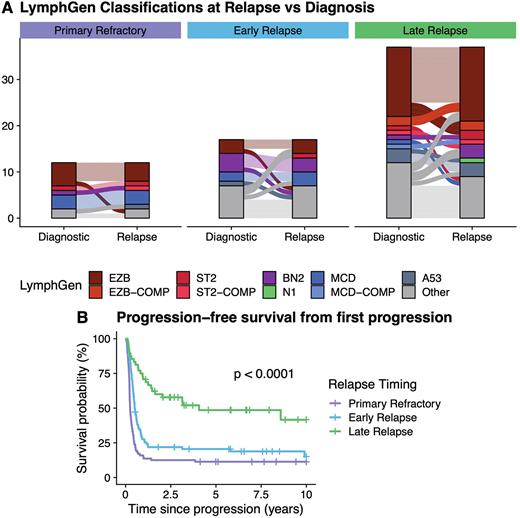Abstract
Introduction: Diffuse large B-cell lymphoma (DLBCL) is cured in over 60% of patients, but outcomes are poor for patients with relapsed or refractory disease (rrDLBCL). While previous studies have examined cohorts of rrDLBCL to identify events that are enriched at relapse, few have directly compared matched diagnostic and relapse biopsies to identify the biological and evolutionary dynamics that drive relapsed disease. Here, we have employed multiple techniques including whole genome sequencing (WGS) to explore the genetic and biological differences between diagnosis and relapse and the relationship to outcomes to salvage therapy.
Methods: Archival formalin-fixed paraffin-embedded biopsies with DLBCL morphology were selected from 146 R-CHOP treated patients, of which 35% had detectable low-grade lymphoma at some point in their disease course. Recurrences were stratified into primary refractory (REFR, n=33), early relapse (ER, n=33), or late relapse (LR, n=80) within <9, 9-24, or >24 months from the first DLBCL biopsy, respectively. Break-apart fluorescence in situ hybridization (FISH, n=116) was used to identify MYC, BCL2, and BCL6 translocations, and the NanoString DLBCL90 (n=93) assay was used to assign cell-of-origin (COO) and DHITsig subgroups. Simple somatic mutations were identified from WGS (n=65 tumor pairs with matched constitutional DNA) or whole exome sequencing (n=4) using an ensemble of four variant callers (Strelka2, LoFreq, Mutect2 and SAGE), somatic copy number variations were detected using Battenberg, and structural variants were detected using Manta and GRIDSS2. Immunoglobulin (IG) rearrangements were identified from RNAseq data (n=46 tumor pairs) using MiXCR. The LymphGen classifier was applied to assign genetic subgroups. Subclonal populations were inferred and assigned to phylogenies using PyClone-VI and PhyClone.
Results: By both FISH and WGS, BCL2 translocations were found to be concordant in matched biopsies in all patients, consistent with their acquisition during V(D)J recombination in early B cell development. In contrast, MYC and BCL6 translocations were discordant in 14 and 15% of tumor pairs by FISH, respectively, and in two FISH-concordant LR patients the diagnostic and relapse biopsies harbored different MYC translocation partners. While COO classifications were mostly concordant (81% of patients), discordance was more frequent in LR pairs, and linear predictor scores were better correlated in REFR (R = 0.97, P < 0.001) and ER (R = 0.9, P < 0.001) than in LR pairs (R = 0.64, P < 0.001).
Within patients, we observed that both the diagnostic and relapse tumors harbor significantly more unique mutations (i.e., not shared between paired tumors) among the LR pairs relative to ER or REFR pairs. These differences rarely affected the LymphGen classification, which was mostly concordant between time points across all relapse timing categories (Fig. A). Although LR pairs had few shared mutations, there was substantial overlap in the set of mutated genes. Among LR pairs classified in the most abundant EZB subgroup by LymphGen, mutations in MEF2B and CREBBP were frequently shared between biopsies. In two patients with frank discordance of LymphGen classifications, these tumors also harbored distinct IG rearrangements indicative of clonally unrelated de novo disease.
We next examined the relationship between relapse timing and outcomes following salvage therapy and hematopoietic stem cell transplant (HSCT). In a cohort of 225 patients treated with salvage chemoimmunotherapy with intention to treat with HSCT, ER and REFR were less likely to respond to salvage therapy (P < 0.001) or receive HSCT (P < 0.001) relative to LR. Overall survival (OS) and progression free survival (PFS) from the time of relapse were significantly shorter in ER (OS: HR = 2.08, P = 0.0032; PFS: HR = 2.34, P = 0.0003) or REFR (OS: HR = 3.77, P < 0.0001; PFS: HR = 4.12, P <0.0001) relative to LR (Fig.B).
Conclusions: These experiments suggest that LRs, when clonally related, usually arise via convergent evolution from a common precursor cell (CPC) population where the driver mutation profile at both diagnosis and relapse is constrained by the genetics of the CPC. The superior outcomes on salvage therapy and HSCT support the hypothesis that LRs generally represent new chemotherapy-naïve disease and have implications for optimal patient management in the era of CAR-T cell therapy.
Disclosures
Ngu:AstraZeneca: Honoraria. Rushton:SAGA Diagnostics: Consultancy. Slack:Seagen: Honoraria. Craig:Bayer: Consultancy; BeiGene: Honoraria. Gerrie:Janssen: Honoraria, Research Funding; Sandoz: Honoraria; AstraZeneca: Honoraria, Research Funding; AbbVie: Honoraria, Research Funding. Freeman:Sanofi: Honoraria; Amgen: Honoraria; Janssen: Honoraria, Research Funding; Bristol Meyers Squibb: Honoraria, Membership on an entity's Board of Directors or advisory committees; Incyte: Honoraria. Villa:AstraZeneca, Roche: Research Funding; Roche, AstraZeneca, Abbvie, Janssen, Kite/Gilead, BMS/Celgene, BeiGene, Kyowa Kirin: Consultancy, Honoraria. Savage:Beigene and Regeneron: Membership on an entity's Board of Directors or advisory committees; BMS, Janssen, Kyowa, Merck, Novartis, and Seattle Genetics: Consultancy, Membership on an entity's Board of Directors or advisory committees. Sehn:Chugai: Consultancy, Honoraria; AbbVie, Acerta, Amgen, Apobiologix, AstraZeneca, BMS/Celgene, Debiopharm, Genmab, Gilead, Incyte, Janssen, Kite, Karyopharm, Lundbeck, Merck, Morphosys, Novartis, Sandoz, Seattle Genetics, Servier, Takeda, TG Therapeutics, Verastem: Consultancy; AbbVie, Acerta, Amgen, Apobiologix, AstraZeneca, BMS/Celgene, Gilead, Incyte, Janssen, Kite, Karyopharm, Lundbeck, Merck, Morphosys, Sandoz, Seattle Genetics, Servier, Takeda, TG Therapeutics, Verastem: Honoraria; Teva, Roche/Genentech: Consultancy, Honoraria, Research Funding. Steidl:Abbvie: Consultancy; Bayer: Consultancy; Bristol Myers Squibb: Consultancy; Curis Inc: Consultancy; Epizyme: Research Funding; Roche: Consultancy; Seattle Genetics: Consultancy; Trillium Therapeutics: Research Funding. Scott:Abbvie: Consultancy; AstraZeneca: Consultancy, Honoraria; Roche: Research Funding; Janssen: Consultancy, Research Funding; Incyte: Consultancy; NanoString: Patents & Royalties.
Author notes
Asterisk with author names denotes non-ASH members.


This feature is available to Subscribers Only
Sign In or Create an Account Close Modal